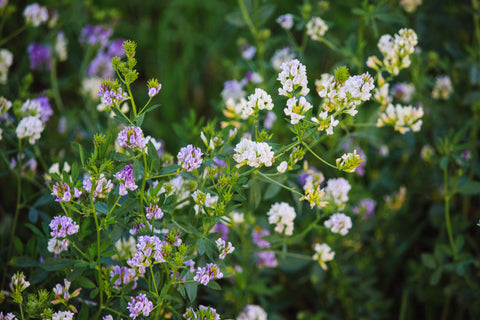Cover crops for your garden or fields provides benefits for building soil health and retaining nutrients in the soil for successive crops.
Regardless of what is growing - flowers, vegetables, grass, or crops, soil should have a living cover for as many months of the year as possible.
Common plants used in cover crops include non-specific varieties of grains such as rye, oats, barley, wheat, triticale, buckwheat or other cereal grains. Vetch, clover, and annual ryegrasses are common in cover crop rotations, as well as brassicas such as turnips, radishes, rape, etc.
7 benefits of Cover Crops: 
- Reduce erosion or loss of topsoil
- Reduce compaction
- Reduce runoff, leaching, and volatilization of nutrients
- Improve soil organic matter
- Improves water infiltration and drainage
- Improves soil structure retention
- Provides microbiome food and a stable environment
Using the principles of feeding the soil to feed the plants, sustainability can improve dramatically. The bacteria, fungi, and other microbes living in the soil create a symbiotic relationship with the plants growing. Once a good balance of Soil pH, Organic Matter, Cation Exchange Capacity (CEC), and Nutrients are stabilized in the soil over time, the balance becomes easier to maintain and the soil health improvements are evident in less weed and pathogen pressure, healthier crops, higher yields, and less input costs. Symbiosis occurs when healthy soils are able to support more beneficial microbe populations which in turn can break down and provide the growing plant's nutrients that are already present in the soil and from the microbial waste stream. In other words, happy, healthy soil microbes, provide food and an ideal soil substrate for healthy productive plants.
Feed the microbes to feed the plants!
Ask us about soil testing and a plan to help improve the health of your soil!

























